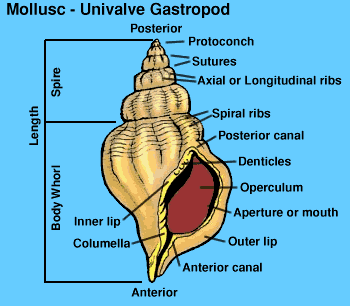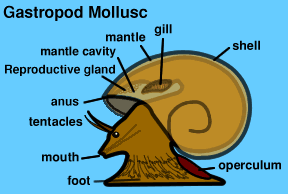Gastropods
| The Class Gastropoda belongs to the Phylum Mollusca. Gastropods include the sea snails, land snails, slugs, sea hares, limpets, abalones, turbans, tritons and cones. Gastropods are soft bodied animals, with a head, foot, visceral body mass and a mantle, often protected by a shell. But not all gastropods have a shell, such as the beautifully coloured nudibranchs.
Many gastropods are able to withdraw into a spiral shell and close off the aperture with a covering door or lid, called an operculum. Others like the limpet, have a cone-shaped shell, and do not have an operculum cover. When first hatched from the egg, the small mollusc creates a protoconch. As it grows, the mollusc adds extra calcareous material onto the outside edge of the shell. Univalve mollusc shells usually grow as an enlarging spiral. The suture divides one whorl from another. Shell sculpture often consists of ribs, bumps or other ornate markings. Ribs may be axial or longitudinal, running parallel to the axis of the body from the anterior to the posterior. Spiral ribs run around the whorls. Other forms of sculpture may be denticles, which are bumps that look like teeth, or pustules that look like pimples. Some shells may have long spines, and other extensions, which may be a camouflage, or assist the mollusc in some other way.
During their larval life stages, all gastropods go through a body-change process called torsion, or twisting. The mantle cavity moves from the rear position and comes to rest over the head, facing forward towards incoming water. So inside the mantle cavity are the gills, anus and reproductive glands, which lie directly over the head. This would seem to have some advantages and some disadvantages. The advantage is that the gills face fresh incoming oxygen-charged water. The disadvantage is the excreta from the anus comes out just above the head. But the mantle cavity is designed so the poisonous wastes are quickly dispersed into the water and are quickly washed away from the mollusc. The reproductive gametes and ova are also sent out into the water in this way as well. | Chitons Home Page
|
|
| |





0 Komentar:
Posting Komentar
Berlangganan Posting Komentar [Atom]
<< Beranda